by Matt Corrion
What a summer we are having- wildfires, heat, and drought. Hopefully you have already renovated your landscaping to make it more adapted to our climate. The old “imported” landscaping look of 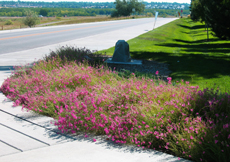 bluegrass and high water-use plants is really showing it wear in this heat.
bluegrass and high water-use plants is really showing it wear in this heat.
Assuming you followed most of the suggestions in my spring landscape maintenance tips, you got the summer started on the right foot. This will allow you to relax a little more over the summer to enjoy your landscape and barbecues with family and friends. But with summer is full swing and the west abound in hot temperatures, there are a few important landscape maintenance tasks that you will want to keep up with.
Key Dates / Weather Considerations
- The month of July: July is Colorado’s hottest and driest month. Take a look at the bar chart below showing the spike in temperature during July. This means that watering will need to be increased for bluegrass lawns and even many of the xeriscape plants.
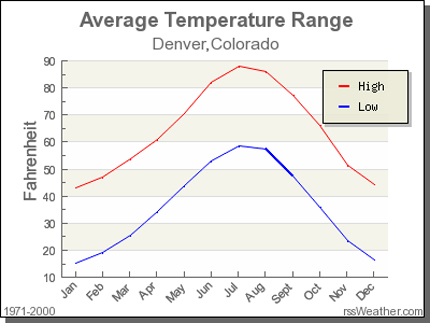
- On average, we also actually see a spike in precipitation in July. But this is usually due to large afternoon storms, rather than consistent rainfall. We may go 2 weeks with 100 degree temperatures and no rainfall. Then there may be afternoon monsoon storms for 3 days in a row. It is important to monitor the moisture that your plants are receiving, but also watch for flooding and erosion that can occur in bed areas, and around walls, patios, and other hardscapes from these large storms.
- Hail can also be a factor (fingers crossed that it won’t), although I have found that the more native and regionally adapted the landscape is, the more it can recover from being decimated by hail. Plants seem to have evolved to expect hail in this region of the country.
Trees and Shrubs
- Monitor soil moisture. Provide supplemental watering and/or increase watering times on your drip irrigation system during hot, dry periods.
- Watch for pests and manage them accordingly, as many insects will attack plants when they are under stress from drought.
- Assess which of your plants are under stress from the heat- Consider moving plants that prefer more moisture and shade to a different, more shady location so they will be happier next year. But don’t do any transplanting now, it’s too hot- wait until late August at the earliest.
Perennials and Ornamental Grasses
- Ornamental grasses do not need much care during this period. Most of them should be thriving right now- enjoy the beauty, movement, and texture that they provide!
- Some perennials that are done flowering can be dead-headed to promote another round of flowers!
- Watch soil moisture closely, and add additional mulch around the base of plants if mulch has thinned out. This keeps the roots cool and helps preserve soil moisture.
Lawns
- Hopefully you have followed the 7 Principles of Xeriscape, and have limited your turf areas to those places that are most practical. This is the season where it really pays off (in improved aesthetics, reduced maintenance, and lower water bills).
- You will probably have to increase watering during the middle of summer. However, keep in mind that many turf grasses such as bluegrass will go dormant (the lawn will turn brown) if not extensively watered. This does not mean that the lawn is dead. It has simply gone dormant, and will green back up when temperatures cool and it receives more rainfall.
- Some weed species can be a problem in lawns during mid-summer, especially if the lawn has gone dormant or partially dormant- the weeds do not have much competition. Consider using weed control products and herbicides. Always handle these products carefully, and consider organic options if they are available.
Planting Beds
- Weeding is important during the summer months. Small weeds can easily be pulled, but if they are let go for several weeks they will grow fast in the warm temperatures, making the job much more difficult. It can be pretty easy, and even enjoyable. Just grab a glass of wine in one hand, and stroll through your garden pulling the small weeds before they get out of hand.
Other
- Protect your bees, butterflies, and hummingbirds. Bees will be abundant on your flowering plants- in many areas of the country bees are disappearing, so be sure not to use pesticides on any areas that my impact your bees!
While spring and fall are probably the most critical seasons for landscape maintenance, summer is a time to relax and enjoy your landscape while trying to keep cool. If you spend a few evenings or cool mornings following some of these summer landscape tips, you will achieve piece of mind and your landscaping will be in great shape.
This is the official blog of Outdoor Design Group, Colorado Landscape Architects. For more information about our business and our services, click here.
Related Posts:
by Matt Corrion
By now most people in the western U.S. are familiar enough with Xeriscape to know that there is indeed no “zero” in the pronunciation (it’s pronounced more like zeer-escape). The term 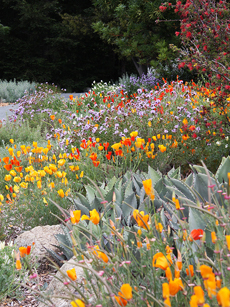 was coined by the Denver Water Department in 1981, are derived from the Greek word “xeros”, meaning dry.
was coined by the Denver Water Department in 1981, are derived from the Greek word “xeros”, meaning dry.
There are 7 principles that make up the concept of Xeriscape: planning and design, improving the soil, creating practical turf areas, irrigating efficiently, proper plant selection, using mulch, and maintaining the landscape.
While I am not sure EXACTLY when the 7 principles were first released (my guess is a few years after the term Xeriscape was first used), I have often wondered whether an update was needed, or if the same 7 principles would be adopted exactly the same today.
While today Xeriscape remains as relevant as ever, there are some important observations I have made through experience regarding the 7 principles, common misconceptions about them, and how they relate to landscaping in today’s rapidly changing world. Therefore, I thought it might be helpful to revisit and add updates to the original 7 principles:
Principle #1: Planning & Design
Updates: Planning and design is as important today as ever. Landscapes continue to get more complex as dozens of new plant choices are introduced each year, along with advances in irrigation systems and controllers. The more complex a project gets, the more benefit is gained from careful planning and design.
Another important development has been the landscape architecture license act of 2007, when Colorado joined the rest of the country in requiring that landscape architects be licensed, and that all commercial and large residential projects (greater than 4 units) have landscape plans that have been prepared by a licensed landscape architect. While this may have raised the cost of design somewhat, a good efficient design will always pay for itself by minimizing surprises during construction, allowing plans to be competitively bid, and lowering maintenance costs over time.
Misconceptions: Xeriscape can only be done in one style. A design will make the project cost more.
Principle #2: Soil Improvements
Updates: This is one area that needs to be looked at closer. The intention of this principle should be to “analyze and improve soil when needed, depending on what plantings are proposed”. The problem has been that many cities and municipalities started to require that all landscaped areas have large amounts of amendment incorporated into the soil over the entire landscaped area, and even requiring dump tickets from the contractors to prove that the amendments were placed.
While this is a good idea for bluegrass and for some types of plants, there are many other plants were the amendment is detrimental to plant health. Many of the very xeric and native plants prefer the native, rockier soil, and can suffer from root rot if soil is heavily amended with organics. I personally think that the amendment should only be tilled into new bluegrass areas, and in the individual planting backfill of those plants that will benefit from it.
Misconceptions: All plants require soil improvements.
Principle #3: Practical Turf Areas
Updates: I am not sure whether the original principle read “Practical Turf Areas” or “Practical Bluegrass Sod Areas”. One of the trends I am seeing that we are starting to use in our designs is the creation of “turf” areas from groundcovers and/or spreading perennials and shrubs. The questions that one needs to ask is not only where will the lawn areas be, but does an area really need to be a “lawn” at all?
Many of the bluegrass turf alternatives are very difficult and sometimes expensive to get established. If an area of the landscape will not be used for games and high foot traffic, then why substitute a hard-to-grow lawn alternative for bluegrass when there are many good spreading plants that are easy to grow? In other words, if a “turf” area will not be used, it simply becomes a low growing visual element, in which case many planting alternatives should be explored.
Misconceptions: Xeriscape means no grass, and bluegrass turf cannot be used in a Xeriscape.
Principle #4: Efficient Irrigation
Updates: Many advancements in irrigation have been made in the past several years, making it possible to irrigate even more efficiently. However, many of these benefits have been over-hyped. While I am all for making our irrigation systems more efficient, this approach does not address the underlying issue- how much water does my landscape REQUIRE to remain healthy? Only by installing water efficient landscapes will any major impact be made.
Misconceptions: If one installs new irrigation heads and a smart controller, the amount of water they will need to use will go down significantly.
Principle #5: Proper Plant Selection
Updates: This principle goes hand-in-hand with a good design. One of the overlooked aspects of this principle is a phenomenon known as “micro-climates”. Microclimates are small climate differences that occur in the landscape due to sun vs. shade relationships, water availability and retention, wind, soil differences, etc. Every day in this business I am reminded how plant selection is impacted by these micro-climates.
One area of debate is the natives vs. non-natives argument. I am firmly in the non-natives camp. There are some amazing native plants that I love to use, but there are also many non-natives discovered every year that meet the needs of our varying miro-climates.
Misconceptions: Only native plants are appropriate to use.
Principle #6: Mulching
Updates: The biggest problem I see with this principle is that all mulches are not created equal. There are cost, aesthetic, and weight differences between wood mulch and rock mulch. Not all plants like being heavily mulched, and some prefer rock mulch over wood mulch, for many of the same reasons some plants do not like a lot of soil amendment. As a result, wood mulch seems to be getting a bad name for Xeriscapes. I have even seen some cities write into code that wood mulch cannot be used for a low water-use zone. But wood is often quite a bit less expensive than rock mulch, and is WAY easier to move around, plant in, and make adjustment to than rock.
The bottom line on mulching- there are different rules to follow based on the type of mulch you are using. If you use wood mulch, use a thin layer and be sure not to over-water. If you use rock, remember that it will be difficult to add plants later or make changes to rocked areas. Also, keep in mid the aesthetics- I feel that too much rock can make a landscape seem a little too harsh, and but having a combination of mulch types can help to visually break up large areas.
Misconceptions: All mulch is the same, all plants love being mulched.
Principle #7: Maintenance
Updates: This is the most undervalued principle. For every 10 beautiful landscapes that I have designed and enjoy visiting time and again, there is at least one commercial landscape where even the most basic maintenance has been neglected. Shrubs have been sheared off into little balls right before they were about to flower, weeds have overtaken a bed area, plants have been over-watered to death.
The biggest piece of advice I can give to property owners or managers is this: walk your landscape once in a while, and make maintenance adjustments based on what you see. Remember that plants are living things, and your job is to understand what will allow each plant to flourish naturally, with the least amount of interference (such as over-watering, over-pruning, etc.) while at the same time minimizing negative factors such as pests, weeds, etc.
Misconceptions: All plants like more water, all shrubs need to be pruned, all plants have similar needs.
This is the official blog of Outdoor Design Group, Colorado Landscape Architects. For more information about our business and our services, click here.
Related Posts:
by Matt Corrion
On March 15, 2012, facilities across the United States must comply with the revised ADA (Americans with Disabilities Act) design standards adopted in the 2010 Standards for Accessible  Design.
Design.
The 2010 Standards set minimum requirements for newly designed and constructed or altered State or local government facilities, public accommodations, and commercial facilities to be readily accessible to and usable by individuals with disabilities.
I have reviewed the new standards, and they are pretty extensive. Property owners and designers should be aware of some of the changes that will be required when constructing or altering a facility.
The provision requiring accessible means of entry/exit for swimming pools has gained a lot of attention. On March 15th, the US Attorney General signed an extension of 60 days for this particular provision, while also opening up a public comment period.
The swimming pool provision, along with other key new provisions, as taken from the ADA website, include:
2. Recreational Boating Facilities (Sections 235, 1003)
If boat slips are provided at a boating facility, the minimum number that must be accessible depends upon the size of the facility. Accessible boat slips must be dispersed throughout the various types of boat slips.
Where boarding piers are provided at boat launch ramps, at least 5% (but no fewer than one) must be accessible. Gangways that are part of a required accessible route are to be accessible, subject to certain enumerated exceptions.
4. Fishing Piers and Platforms (Sections 237, 1005)
Newly designed, newly constructed, or altered fishing piers must provide accessible routes, subject to the same exceptions permitted for gangways. At least 25% of guardrails or handrails must be no higher than 34 inches and must be dispersed. Clear floor or ground space must be provided at each accessible railing, and turning space must be provided on the pier.
5. Golf Facilities (Sections 238, 1006)
Newly constructed and altered golf facilities must have either an accessible route or golf car passages with a minimum width of 48 inches connecting accessible elements and spaces within the boundary of the golf course. An accessible route must be provided to the golf car rental area, bag drop-off areas, and other elements that are outside the boundary of the golf course. One or two teeing grounds (depending on the total number provided) per hole must be accessible.
If weather shelters are provided, a golf car must be able to enter and exit the shelters. Certain percentages of practice teeing grounds, practice teeing stations at driving ranges, and putting greens must be accessible.
6. Miniature Golf (Sections 239, 1007)
At least fifty percent of all holes on a miniature golf course must be accessible. These accessible holes must be consecutive, and they must be on an accessible route. The last accessible hole must be on an accessible route that connects to the course entrance or exit without going back through other holes.
7. Play Areas (Sections 240, 1008)
Play areas designed, constructed, and altered for children ages two and over in a variety of settings, including parks, schools, childcare facilities, and shopping centers, are covered.
Accessible ground and elevated play components, accessible routes, ramps and transfer systems (typically a platform or transfer steps), and accessible ground surfaces must be provided.
8. Swimming Pools, Wading Pools, and Spas (Sections 242, 1009)
Accessible means of entry/exit are required for swimming pools. Such accessible means of entry include a pool lift or sloped entry, and either a transfer wall, transfer system, or pool stairs. Wading pools must provide a sloped entry, and spas must provide a pool lift, transfer wall, or transfer system. Wave action pools, leisure rivers, and sand bottom pools where user access is limited to one area shall not be required to provide more than one accessible means of entry, either a pool lift, sloped entry, or a transfer system.
This is the official blog of Outdoor Design Group, Colorado Landscape Architects. For more information about our business and our services, click here.
Related Posts:
by Matt Corrion
You may have heard that you can save big bucks on water and maintenance by renovating your landscaping to be more water-efficient.
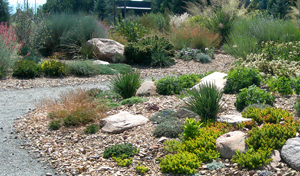
But, did you know that Cities across the country will pay you cash to do it?
As water supplies dwindle and populations rise, many municipalities are offering great incentives for reducing water use in the landscape. When property owners, businesses, or managers factor in the payback from these rebates along with the water and maintenance savings, a landscape renovation can make a lot of sense.
The 2 Main Types of Rebates
Generally speaking, incentives for reducing water use fall into two categories. The first category is paying customers to remove landscapes that have high water use and replace them with attractive low water use plantings, and the second category is to provide rebates for purchasing and installing irrigation components that reduce water use and that are more efficient than older systems.
As we have discussed in the past, the real water savings (as well as the largest rebates) come from replacing high water use lawns and landscaping, with new plantings that require less water and are more adapted to the local climate. There are many benefits to this approach- see The Top 10 Benefits of Making Landscaping More Water Efficient.
14 Specific Examples of Rebate Programs
Incentives for Removing Turf: $0.75 per square foot for single family homes and multi-family or commercial properties.
Equipment Rebates: Rebates for smart controllers, rain sensors, rotary nozzles, and equipment for removing sod and placing compost.
Additional Program Notes: Rebates of up to $150.00 are also offered for rainwater collection systems, and with the installation of a rainwater collection system the incentives double to $1.50 per square foot. Residents may also receive a $20.00 credit for attending a water efficiency class.
Equipment Rebates: Rebates for smart water controllers, weather sensors, and moisture sensors for single homes and multi-family or commercial properties.
Additional Program Notes: Rebates include 50% of the purchase price for valves, and $75.00 per drip zone installed.
Incentives for Removing Turf: $1.00 per square foot, up to $10,000 for single family homes, and up to $25,000 for multi-family or commercial properties.
Additional Program Notes: Rebates are also available for removing old hardscapes, and for seeding areas with native grasses.
Incentives for Removing Turf: $18.50 per 1,000 gallons of water saved for multi-family or commercial properties.
Equipment Rebates: Single family residential customers can receive $2.00 per efficient nozzle and $100.00 for weather-based smart controllers with rain sensors. Multi-family or commercial properties can receive $2.00 per efficient nozzle, and 25% of the cost of a smart controller.
Equipment Rebates: Single family residential customers can receive up to $1,000 for installing smart controllers and rain sensors. Multi-family or commercial properties can receive up to $5,000 for installing smart controllers and rain sensors.
Additional Program Notes: Rebates are also available for rotary nozzles, mpr spray heads, pressure reducing drip valves, and backflow prevention devices specifically made for drip systems.
Incentives for Removing Turf: $0.25 per square foot for installing drought tolerant Buffalo Grass for single family homes and multi-family or commercial properties.
Equipment Rebates: Rebates of $50.00 for moisture sensors, and 50% of the purchase price of a drip irrigation system are available for single family homes and multi-family or commercial properties.
Equipment Rebates: Single family residential customers can receive up to $550.00 for installing smart controllers, rain sensors, and rotary nozzles. Multi-family or commercial properties can receive up to $3,550.00 for installing smart controllers, rain sensors, and rotary nozzles.
Additional Program Notes: Rotary nozzle rebates are available for up to $200.00 for single family residential, and up to $2,000 for multi-family or commercial properties. Rebates are available for 50% of the purchase price of smart controllers and rain sensors.
Incentives for Removing Turf: Rebates of up to $1,650 are available for single family homes and multi-family or commercial properties.
Equipment Rebates: Rebates of up to $250.00 are available for installing smart controllers.
Incentives for Removing Turf: Up to $3,000 for single family homes and multi-family or commercial properties.
Equipment Rebates: Single family residential customers can receive up to $250.00 for installing smart controllers. Multi-family or commercial properties can receive up to $1,250.00 for installing smart controllers.
Additional Program Notes: A minimum area of 1,000 square feet of turf must be removed to qualify for turf removal incentives.
Incentives for Removing Turf: $1.50 to $1.00 per square foot, up to $300,000 for single family and multi-family or commercial properties.
Equipment Rebates: 50% of the cost of smart controllers, and $25.00 for rain sensors for single family and multi-family or commercial properties.
Incentives for Removing Turf: $1.50 per square foot up to $3,000 for single family homes, and $1.50 per square foot up to $9,000 for multi-family or commercial properties.
Equipment Rebates: Single family residential customers can receive up to $400.00 for installing smart controllers. Multi-family or commercial properties can receive $25.00 per station up to 68 stations ($1,700) for installing a smart controller.
Additional Program Notes: Rebates of $0.50 for every gallon of storage capacity up to 400 gallons are offered for rainwater collection systems.
Incentives for Removing Turf: $0.75 per square foot up to $2,000 is available for for single family homes, and $0.75 per square foot up to $20,000 is available for multi-family or commercial properties.
Equipment Rebates: Rebates are available for smart controllers, rain sensors, rotary nozzles, and dedicated landscape meters.
Additional Program Notes: Rebates of $1.50 per square foot up to $30,000 are also available for commercial properties through a “cost sharing areas” program.
Equipment Rebates: Single family residential customers can receive up to $375.00 in equipment rebates. Multi-family properties can receive up to $500.00 for new equipment.
Additional Program Notes: Rain water harvesting rebates of up to $5,000 are available for no-pressurized or pressurized systems.
Incentives for Removing Turf: Rebates of up to $400.00 are available for reducing water bill for single family homes and multi-family or commercial properties.
Equipment Rebates: Rebates of up to $3,200 are available for installing smart controllers, rain sensors, and rotary nozzles.
Additional Program Notes: Incentives are offered for capping irrigation zones and/or converting existing irrigation systems to drip.
These incentive and rebate programs are typically limited to a maximum allowable rebate amount based on the area of the project, and the purchase price of the irrigation components. Many of the programs also are only available on a first come first serve basis. With limited funding many municipalities exhaust their funds in the first few months of the year. Other program requirements include selecting plants from specific drought tolerant or native plant lists, percentage of plant area coverage, and the make and model of irrigation components.
Because of the complexity of the projects and the paperwork involved, it may make sense to have a landscape architect assist you for a moderate fee. These professional consultants can prepare any plans that are needed, submit applications, gain approval from local building departments and HOA’s, and maximize the potential rebate amount you will get back.
In addition, most states require a licensed landscape architect to prepare plans for any major renovation on a commercial or larger residential property. The fees for these services are often offset by the savings that come from having a good plan that can be accurately bid and installed by contractors.
So, if you are looking to make your property more sustainable, update it’s image, and save on maintenance and water, look into what programs may be available in your area.
This is the official blog of Outdoor Design Group, Colorado Landscape Architects. For more information about our business and our services, click here.
Related Posts:
by Guest Writer
If you’re in the market to replace your existing deck or want to build a new one, you will want to know what products are available and what your contractor can do with them.
A beautiful deck starts with careful planning and design. The best looking deck often reflects some architectural elements from the house and uses them in the deck. If you have multiple decks on your home consider using matching handrails and decking material for uniformity. Consult with your builder or designer for the many options available today.
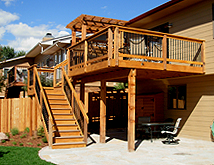 Overall deck costs tend to range from $25-$35 per square foot and cost varies due to height and complexity of construction. The cheapest decking material on the market is probably pressure treated pine the most expensive include exotic hardwood species and top-end coated composite decking. Here is a quick run-down on some of the decking materials available:
Overall deck costs tend to range from $25-$35 per square foot and cost varies due to height and complexity of construction. The cheapest decking material on the market is probably pressure treated pine the most expensive include exotic hardwood species and top-end coated composite decking. Here is a quick run-down on some of the decking materials available:
Decking Materials:
Redwood – soft wood prone to damage from hail, includes the removal of old growth forests that take centuries to recover. Redwood takes hundreds of years to mature and therefore is not a sustainable wood source. Redwood coast around $3-4 per linear foot depending upon the quality ordered.
IPE – Brazilian rainforest lumber that is very dense (hard) and durable. It has a dark color and requires pre-drilling for fasteners. I do not know of any that is sustainably grown / harvested lumber. IPE costs around $4 per linear foot depending on thickness used.
Tigerwood – Brazillian or African rainforest lumber that is very dense (hard) and durable. It has a light dark color variation (tiger striping) and requires pre-drilling for fasteners. I do not know of any that is sustainably grown / harvested lumber. Tigerwood costs around $4 per linear foot depending on thickness used.
Cedar – Soft wood prone to damage from hail, be sure to specify better grades of wood and tight knot or better, can come rough sawn for beams or trimmers and works well for handrails. Tight knot cedar cost around $2 per linear foot and the price almost doubles for clear cedar.
Pressure treated pine: Typically made from southern yellow pine which is pressure treated forcing chemicals into the wood that resist rotting and insect damage. The treatments usually contain copper compounds & other chemicals that are highly corrosive to metals, so extra zinc treatment to galvanized fasteners is recommended to avoid rusting. Older treated wood, produced prior to 2004, often contain arsenic & chromium which can be easily released if burned. It is important to allow the wood to dry out prior to staining or sealing. Pressure treated wood is prone to warping, splitting and twisting and these qualities seem to be exacerbated in dry climates. I believe that staining & sealing these woods can help their look and performance. P.T. pine should be either screwed in place nailed with 16d ring shank nails all fasteners should be hot dipped galvanized.
Composite:
Should you use real wood or composite decking? In the last ten years composite decking materials (plastic/ wood particles glued together) have taken hold of the market and are used on over half the decks being built. Several companies use 90% recycled plastics in their products which will help reduce waste. However, I do not know of any composites that are recyclable when they need replacement. If decking could be continually recycled it would truly be a sustainable product, but no companies, to my knowledge, have produced such a product. All composite decking materials rely on a type of adhesive or glue that bond all of the plastic and wood particles together. These adhesives can be any number of polymers(resin) some which can cause environmental concern if released into the environment especially if burned. The life span of composite decking is similar to a wood deck that is maintained, around 25 years. Eventually all decking materials will end up in a landfill.
There are around ten different companies producing composite deck materials in the U.S. with Trex being one of the first and widely know. These materials include decking and handrail systems and most companies offer different product lines that vary in color and consistency. One California company even offers a bamboo composite BamDeck which uses 30% bamboo and 70% recycled plastic.
The cost of composite decking varies from $2-$4 per linear foot of decking board. Common sizes for composite decking boards are 12’, 16’, 18’ and some 24’ lengths are available from certain manufacturers. Try to design your deck so that no butt joints are required. Composite boards require spacing butt joints from 1/8”-1/4” for board expansion which can be unsightly.
THE GOOD
- Composite decking does not require as much maintenance as natural wood products.
- Does not splinter or split.
- Have built in slip resistance.
- Are consistent in color, shape, and texture.
- Grooved boards can utilize hidden fastener systems which are attractive.
- Boards can be heated and bent into circular patterns.
- Boards are often made with recycled plastic materials up to 90%, which make it more sustainable.
THE BAD
- Boards without a pvc treatment are prone to staining from many different sources. PVC treatments usually cost around $1 more per linear foot of board.
- Material holds heat and can reach temperatures that will burn bare feet in the summer.
- Material is not structural and typically requires a maximum joist spacing of 16 inches, which also limits what can be done with handrails.
- Material shrinks and swells more that wood which requires spacing at butt joints if used.
- Material requires pre-drilling in many circumstances for fasteners.
- Catastrophic failure, rapid deterioration is possible and almost all manufacturers have had to warranty their product for this reason at one time.
- Material is not recyclable.
- Polymers used to glue product together can be harmful if released into the environment, i.e. burning.
People often ask me what is the best composite to use and to be honest I don’t know. The reason for this is that almost all of the companies making composite materials have produced materials that have failed and needed to be replaced.
In 2009 Louisiana Pacific recalled around 48 million linear foot of decking that was sold under three different trade names (WeatherBest®, ABTCo., and Veranda®). Many other companies have had warranty claims for products that are less than five years old. When composite decking fails you will often notice that the color comes off like chalk when you rub it with a finger.
Once composite decking boards start to fail, they can simply start to rot or you may notice flaking, splits, bubbling or other abnormalities. Boards can also break between joists in extreme failures causing injury. Warranties vary from company to company, but in general you can expect a limited 20 year warranty. One thing to note is that the manufacturer’s warranty will only cover material replacement, not labor to remove the old boards and replace them, which can be a substantial cost. Therefore, do your homework and make an informed decision based on a company’s track record.
Some things you should consider if you are planning to use composite decking:
- Texture (slip resistance) especially in frost prone areas.
- Color – try to compliment your homes color. Most composite deck materials fade 30% in the first year and then stabilize. Some even change color so look at samples that have been weathered when possible.
- Cost – almost everyone is on a budget so pick the best material you can afford.
- Warranty – since there have been failures in the past research the company’s products that you are considering and find out their track record and read the fine print on warranties.
- Maintenance – consult manufacturer’s suggestions but most can be cleaned with mild soaps and water.
There are a lot of things to consider when it comes time to build or replace a deck. A new deck can cost as much as a new car so take the time to weigh your options and hire a competent builder. I suggest that you not only talk with a builder’s past client but also take the time to see one of their completed projects.
No decking is completely environmentally friendly or sustainable. In general, many of the natural wood decking products available are from hardwoods or slow growing softwoods which make them less sustainable. Pressure treated southern yellow pine is a faster growing, more sustainable wood product but it utilizes chemicals for rot and insect resistance. If the composite decking industry can develop a product that is recyclable and will consistently perform it will climb to the top of the sustainability chart and my “A” list.
This is a guest post by Bruce Kehr. The owner of Sunlit Builders, LLC, Bruce is one of the top deck builders in Colorado. You can reach Bruce via email at [email protected].
Related Posts:
 bluegrass and high water-use plants is really showing it wear in this heat.
bluegrass and high water-use plants is really showing it wear in this heat.
 was coined by the Denver Water Department in 1981, are derived from the Greek word “xeros”, meaning dry.
was coined by the Denver Water Department in 1981, are derived from the Greek word “xeros”, meaning dry. Design.
Design.
 Overall deck costs tend to range from $25-$35 per square foot and cost varies due to height and complexity of construction. The cheapest decking material on the market is probably pressure treated pine the most expensive include exotic hardwood species and top-end coated composite decking. Here is a quick run-down on some of the decking materials available:
Overall deck costs tend to range from $25-$35 per square foot and cost varies due to height and complexity of construction. The cheapest decking material on the market is probably pressure treated pine the most expensive include exotic hardwood species and top-end coated composite decking. Here is a quick run-down on some of the decking materials available: